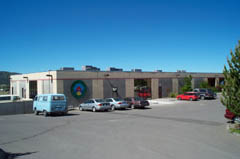
Super Blue Green Algae
The Green Revolution Food Product
GetWell StayWell, America! Independent Distributor Cell Tech Approval #115581
Put The Super Blue Green into Your Life!
Once upon a time, actually, about 7,000 years ago, to be closer to precise, in what we now recognize as "The Cascade Mountains of The Pacific Northwest," mighty volcanoes erupted, each with their own fury and force! And they spread layers of ash "or mineral dust-baths" over the river and lake basin therein.
This basin, spotted with volcanoes, covered 4,000 square miles. And the eruptions and rumblings of these fiery mountains spewed forth millions and millions of tons of mineral ash over this blessed basin. One huge lake 34 miles long enjoyed many of these "ashen-baths." Explorers named it "Klamath Lake." And over the eons, each year, 17 streams and rivers meandered into The Klamath so that they could deposit into the 140 square mile lake 50,000 tons of mineral-rich silt from this volcanic basin. Now, it just so happened that fresh water blue-green algae were able to feed and thrive on the "rich soil-sediment" of all these thousands of years of mineral depositions. Indeed, it is estimated that the blue-green enjoy in Lake Klamath the largest and richest biomass producer in any area in North America! Today, Lake Klamath is recognized
as... "one of the richest, natural nutrient holdings in the
world!" But the wonder of Lake Klamath is that the wild
blue-green growing in her waters have super-high,
nutritional qualities for us human beings!
Algae, then, really belong in a phylum by themselves the "eukaryotics." Now, algae being in a kingdom of their own, neither plant nor animal nor bacteria are classified by color, which is an indication of their nutrient spectrum and their capacity to absorb different spectra of light waves in other words, their color shows their particular "sunshine diet." These families include red, brown, green, golden, and blue-green. The blue-green algae are called "cyanobacteria," and they have the most efficient photosynthetic abilities. Here's the fascinating fact: the blue-green algae produce "the very most nutrient-dense of all foods available to us humans!" The blue-green algae have more nutrients, weight for weight, than any other natural food available to us humans! And it is among the most easy to digest of foods, having a digestible cell wall.
technique, to bring us Health Seekers the
Super Blue Green Algae products.
DO READ ON, DEAR FRIENDS!
Now, algae are not an uncommon phenomena. And, in fact, algae inhabit the world everywhere! Some are microscopic, and some are many feet long. Thousands of varieties flourish around the globe. They exist wherever there is water, or even dampness: in the ocean, lakes, rivers, streams, hot springs, ponds, even rain puddles, and on moist surfaces of plants in your garden. The peculiar thing about algae, however, is that the botanists had trouble deciding if the algae were in the plant or animal kingdom or a bacteria or a little of all three! It was a 3-sided "tri-lemma!" Algae share with the plant kingdom the capacity to photosynthesize and produce chlorophyll; yet they predate the development of the indigestible, cellulose, fibrous cell wall of plants. Algae share with animals a digestible, nutritive, glycogen-like cell wall composed of a starch and exclusive to animals; yet algae cannot be called "animals" since they have no nervous, digestive, or circulatory systems and they contain chlorophyll and not hemoglobin. Still the algae move around like animals, with no roots to hold them down. They definitely look like plants, however, with all their vegetation, and not like animals, at all! Algae don't even have faces! Then, to top off the
"tri-lemma," the algae make Vitamin B-12,
like bacteria! But algae produce chlorophyll:
that keeps them out of the bacteria category!

Upper Klamath Lake

Cell Tech Headquarters
"Why Does Victoria Endorse Super Blue Green Algae?" 4